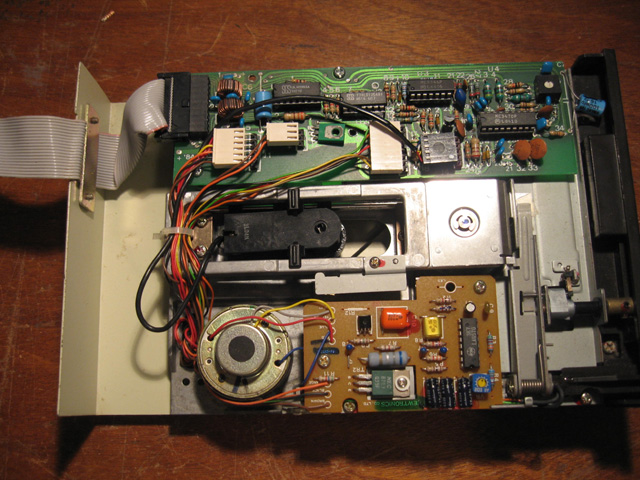tezza
Veteran Member
I'w wondering if anyone can help me with information/schematics etc. on this 5.25 inch disk drive?

It's an Apple II drive, made by Newtronics Co. Ltd. The Model number is D500. The numbers R69-0001 follow the model number on the case.
I got these two drives as part of the Apple haul. They have never worked, but while I have some test equipment I'd like to have a crack at getting them going.
The mainboard in one drive is completely dead. The mainboard in the other drive has cooked two capacitors in a most spectacular fashion! First, the one that was originally there when I first switched it on, and then a replacement sourced from the other board which was also exploded. I'm pretty sure I had the drive plugged in the right way this time. I figure there is a short-circuit on this board.

Problem is I can't do much without schematics. The letters on the cooked capacitor are indecipherable, it looks like + 111 u or maybe 10 u ? There seemed to be a u there before my pliers scuffed up the letters a but. Seems way to small to be 10 uf though? It's about the same size (if not smaller) as the blue caps on the board. 10 pf maybe but I'm sure it was a u not a p.

Anyway this code couldn't fit anything I could recognise. I'm can't really progress until I get a circuit diagram which tells me exactly what's happening on the board and what replacement capacitor I need.
I do have a couple of other working Apple drives as well as these two (and the TEACS) but they are different again.
Any advice or assistance gratefully received. I have higher res scans if anyone thinks that will help.
Tez

It's an Apple II drive, made by Newtronics Co. Ltd. The Model number is D500. The numbers R69-0001 follow the model number on the case.
I got these two drives as part of the Apple haul. They have never worked, but while I have some test equipment I'd like to have a crack at getting them going.
The mainboard in one drive is completely dead. The mainboard in the other drive has cooked two capacitors in a most spectacular fashion! First, the one that was originally there when I first switched it on, and then a replacement sourced from the other board which was also exploded. I'm pretty sure I had the drive plugged in the right way this time. I figure there is a short-circuit on this board.

Problem is I can't do much without schematics. The letters on the cooked capacitor are indecipherable, it looks like + 111 u or maybe 10 u ? There seemed to be a u there before my pliers scuffed up the letters a but. Seems way to small to be 10 uf though? It's about the same size (if not smaller) as the blue caps on the board. 10 pf maybe but I'm sure it was a u not a p.

Anyway this code couldn't fit anything I could recognise. I'm can't really progress until I get a circuit diagram which tells me exactly what's happening on the board and what replacement capacitor I need.
I do have a couple of other working Apple drives as well as these two (and the TEACS) but they are different again.
Any advice or assistance gratefully received. I have higher res scans if anyone thinks that will help.
Tez
